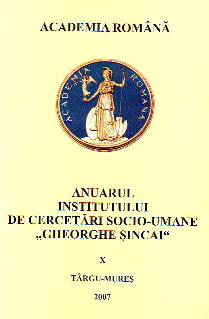Călătoria de studii în Boemia şi Moravia a economistului transilvănean Ioan Neagoe
The Transylvanian economist Ioan Neagoe’s journey of studies in Bohemia and Moravia
Author(s): Ioan ChioreanSubject(s): Cultural Essay, Political Essay, Societal Essay
Published by: Institutul de Cercetări Socio-Umane Gheorghe Şincai al Academiei Române
Keywords: Ioan Neagoe; academic journey; Bohemia; Moravia; Greek Catholic Church; the Habsburg Monarchy; agrarian economy
Summary/Abstract: Ioan Neagoe is the first among the three sons of the Greek-Catholic Archpriest Man from Broşteni and he was born in Armeni, probably in 1729. After having attended the courses of the Saxon gymnasium in Sibiu and of the Jesuit academic college in Cluj, he became a schoolmaster in Blaj, in 1756. A year later, he gave up his didactic position in favor of professional specialization at the highest level in the epoch. In these circumstances, he came to meet Márgai Ferencz, the prefect of the properties in Făgăraş, owned by Count Bethlen Gábor (chancellor in Vienna at that moment). On behalf of his merits in the field of agrarian economy, he was employed as an economic clerk on these properties. In order to become acquainted with the agricultural practices in the most developed provinces of the Empire, Márgai Ferencz sent Ioan Neagoe on a journey of studies in Bohemia and Moravia, where he made researches regarding the acclimation of the potato, a culture recently introduced here on limited parcels. The outcome of this journey would materialize in 1765, when, after a pioneer’s work, he spread the culture of the potato in Transylvania, thus preceding even Austria. Next year, he became a superior clerk in the chancellery of Transylvania and agent of the Greek-Catholic bishop Atanasie Rednic, in Vienna. As a student of Professor Sonnenfels he made studies in the field of politics and the chamber system at the University of Vienna. He included in his interests the fate of the Romanians in the “Hungarian lands”. Unfortunately, he dies of fatigue and illness in December 1771.
Journal: Anuarul Institutului de Cercetări Socio-Umane »Gheorghe Şincai« al Academiei Române
- Issue Year: 2007
- Issue No: 10
- Page Range: 52-57
- Page Count: 6
- Language: Romanian

